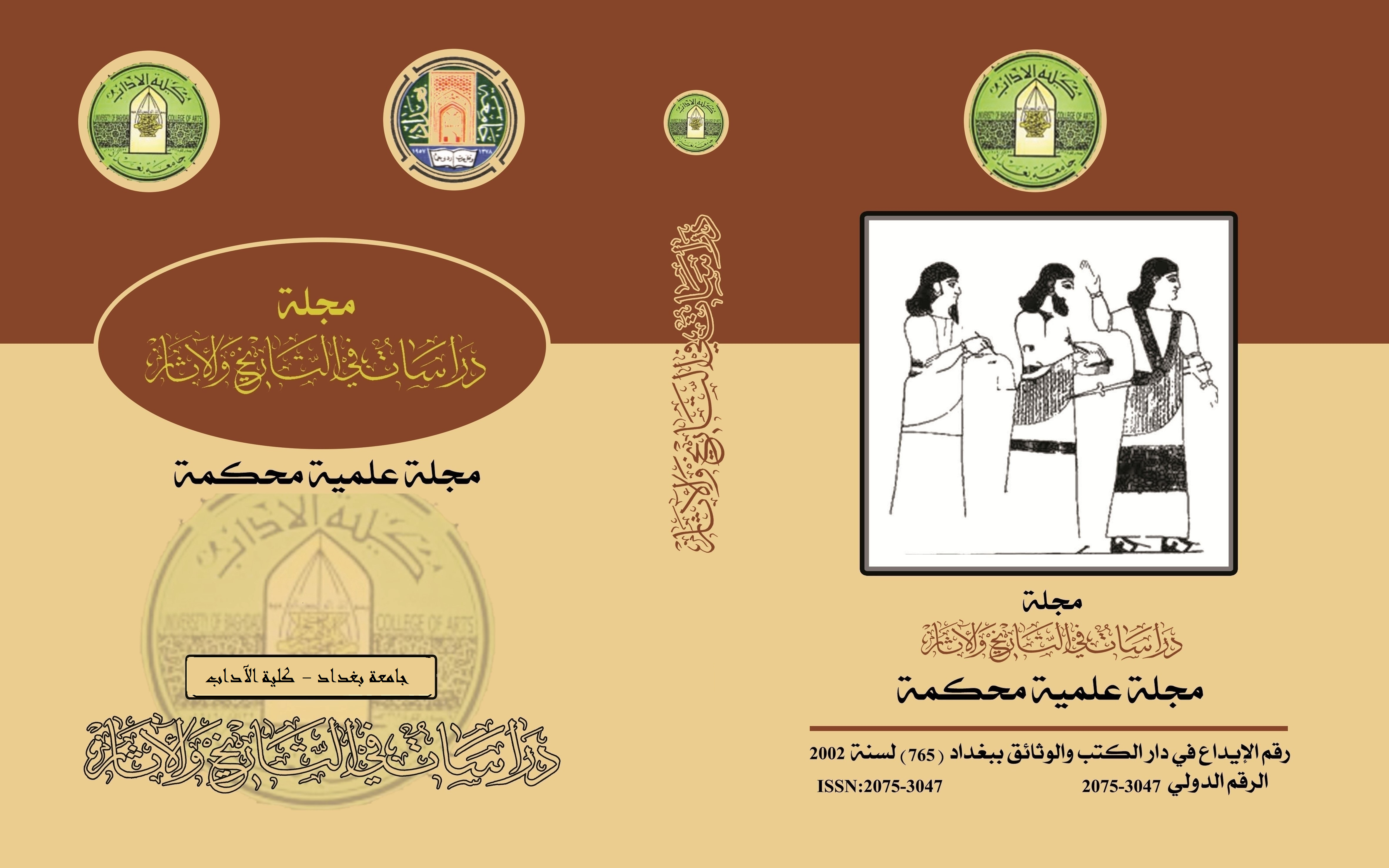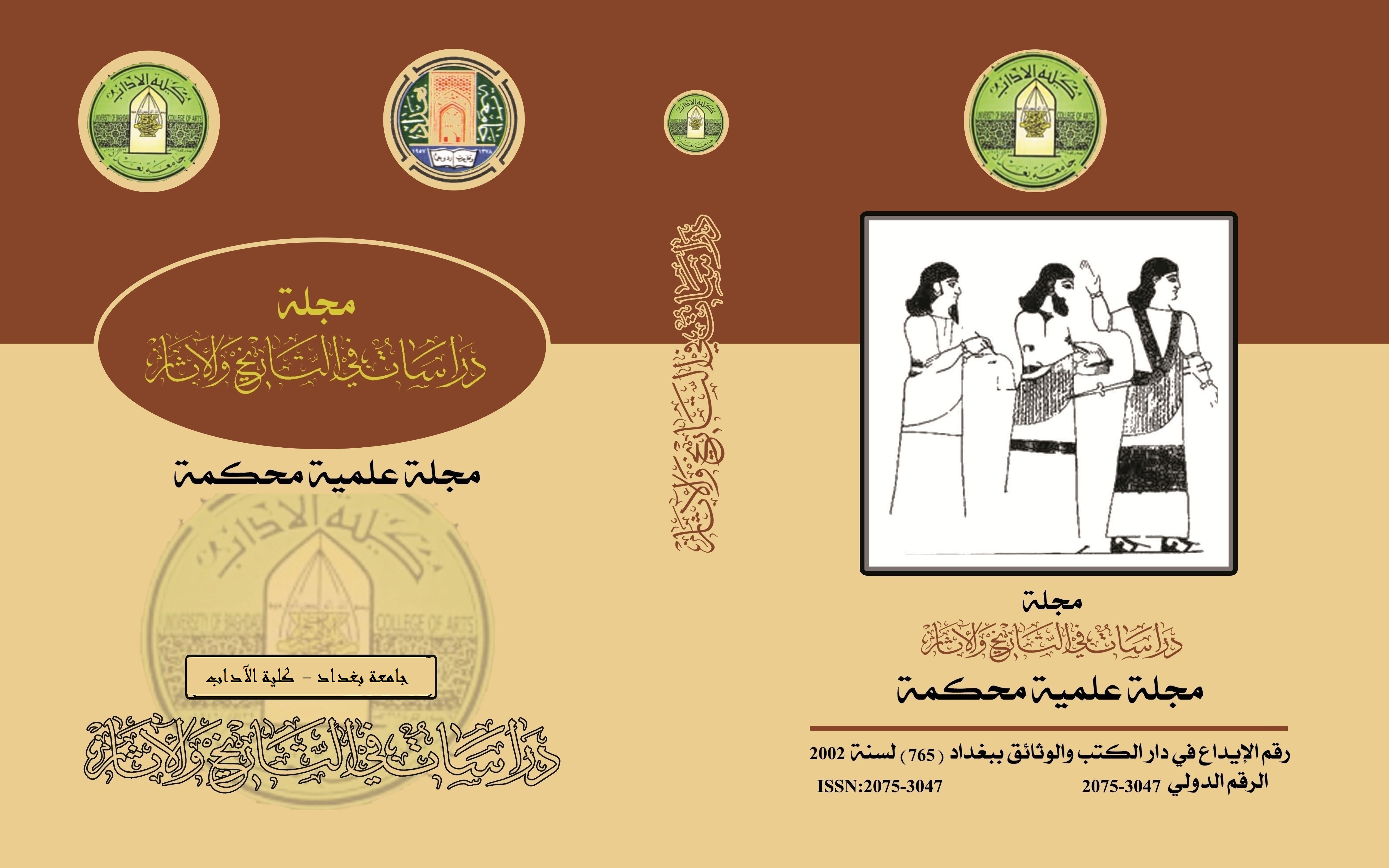آثر سفارات ومراسلات جنكيزخان في تأسيس الأمبراطورية المغولية وتوسعها ( 603 _ 624هـ / 1205 _ 1227م )
الكلمات المفتاحية:
السفارات، المراسلات، جنكيزخان، السفراء، المغولالملخص
سعى الامبراطور المغولي جنكيزخان منذ بداية جلوسه على العرش الى استخدام السياسة السفارات والمراسلات مع حكام وملوك البلدان التي كان ينوي ضمها الى اراضيه وكانت هذه السياسة تهدف الى التسليم وتقديمهم لفروض الولاء والطاعة والخضوع والابتعاد عن المقاومة والحروب , وابتدء ذلك بمراسلة ملك بلاد الاويغور الذي حالما أستغل الفرصة وانشق على القراخطائيين وقَدم الى الخان المغولي معرباً عن رغبته بالانضواء تحت سيادة الامبراطورية المغولية وقد لاقى من جنكيزخان الاستقبال و الترحيب واعاده الى بلاده مكرماً بعد ان صار أحد أتباعه , وبعد ذلك بعث رسوله المسلم جعفر الى التون خان امبراطور مملكة كين الصينية ليتحرى له عن الاوضاع هناك لكن ما حدث مع الرسول ان تم اعتقاله ولكنه استطاع بمهارته الهروب والعودة الى منغوليا واعلام الخان بكل ماصادف و بمسالك الطرق التي سار فيها , وقد كان ماجرى مع السفير المغولي السبب في شن حملات كبيرة ضد هذه المملكة وعلى آثر تلك الحملات استطاع جنكيزخان الانتصار وضم اراضي مملكة كين الصينية الى اراضي امبراطوريته , ولم تسلم مملكة كين الجنوبية في الصين من الخان المغولي فلم يكتف بما حققه في الجبهة الشمالية اذ راسل ملكها وعمل على ابراز القوة التي وصلت اليها الجيوش المغولية وبث الخوف والرعب في نفس الملك وحثه على التسليم والرضوخ لضمان نجاته , حيث عملت هذه الرسالة على زعزعة ثقة الملك واضطر للتسليم ولكنه حاول التلاعب مع الخان المغولي عن طريق نقله لعاصمته بهدف ابعادها عن الحدود المغولية وذلك الحدث دفع جنكيزخان لشن الحرب واخضاع البلاد بالقوة .
وعلى الرغم من عدم وجود اشارة صريحة في المصادر المغولية الى المراسلات التي زعمت المصادر الاسلامية عن وجودها بين جنكيزخان والخليفة العباسي الناصر لدين الله و وحث الاخير للخان المغولي لغزو اراضي الدولة الخوارزمية , ورغم اختلاف المؤرخين مابين مؤيد ومعارض ومشكك الا أنها كانت احد الاسباب الاساسية لسقوط الخلافة العباسية واندثارها الى الابد , وقد تبادل الامبراطور جنكيزخان والسلطان محمد خوارزمشاه السفارات والمراسلات وعقدت المعاهدات التي تنص على احلال السلام بين الدولتين وعزمهم على تأمين الطرق التجارية بين الجانبين وفعلاً سارت القوافل التي تحمل البضائع من عند المغول لكن طمع حاكم مدينة اترار بما تحمله القافلة دفعه الى قتل التجار والاستيلاء على كل ما كانوا يحملون معهم ولما علم جنكيزخان ثار غضباً لكن كان لحكمته وتعقله دوراً في تهدئة الامور اذ ارسل سفراءه للتفاوض مع السلطان محمد خوارزمشاه طالباً تسليم حاكم المدينة الذي تجرء وقتل التجار الا ان السلطان لم يتعض وزاد في عناده وقتل احد السفراء فكان ذلك سبباً في خسارته لملكه اذ شن جنكيزخان الحملات العسكرية ضد اراضي الدولة الخوارزمية وتمكن من اخضاعها الواحدة تلو الاخرى .
وقد أستغل جنكيزخان الشقاق الذي وقع بين السلطان محمد خوارزمشاه ووالدته تركان خاتون التي كانت صاحبة قوة ونفوذ في البلاد فأرسل لها سفيره داشمند الحاجب ليعرض لها مسالمته و بأنه لا ينوي السيطرة على ما تملكه من بلاد وان الحرب بينه وبين ولدها خوارزمشاه فقط , وعليه دعاها الى ارسال شخص من قبلها ليسلمه فرمان توليها عدد من المدن , ولكن ما حدث هو ان تركان خاتون لم تطمئن لنوايا الخان المغولي ولم ترد على سفارته وذلك ادى الى أسرها بعد مدة من الزمن و بقيت ذليلة عند المغول الى ان وافاها الاجل .
ولم يكن جنكيزخان يبعث السفارات للحكام والملوك والسلاطين فقط , بل كان يرسل سفرائه الى سكان المدن المزمع فتحها , فأرسل رسوله حسن حاجي ليحث سكان مدينة سقناق على الخضوع والتسليم الا انه قتل من قبل بعض المجرمين , وثار جند المغول انتقاماً لروح هذا السفير واسقطوا المدينة ومحوا سكانها من الوجود , وعندما كانت النية فتح مدينة بخارى بعث الامبراطور المغولي برسول الى اهالي المدينة ليقنعهم بعدم المقاومة وكاد ان يواجه نفس مصير حسن حاجي لو لا كلامه الذي بعث الاطمئنان في نفوس الاهالي وايقنوا عدم قدرتهم على مواجهة الجيوش المغولية فأمنوا على انفسهم وسلموا المدينة من دون اي حرب.
المراجع
أولاً : المصادر الأصيلة :
1_ ابن الاثير , ابو الحسن عز الدين علي بن ابي الكرم محمد بن محمد بن عبد الكريم (ت630هـ/1232م) , الكامل في التاريخ , راجعه : محمد يوسف الدقاق , بيروت : دار الكتب العلمية , 1424هـ/2002م .
2_ ابن العبري , غريغورس ابو الفرج بن هارون الملطي (ت685هـ/1286م) , تاريخ مختصر الدول , صححه الاب انطون صالحاني اليسوعي , بيروت : دار الشرق , 1992م.
3_ ابن الفوطي , كمال الدين ابو الفضل عبد الرزاق بن احمد (ت723هـ/1323م) , تلخيص مجمع الاداب في معجم الالقاب , تحقيق محمد الكاظم , طهران : مؤسسة الطباعة والنشر وزارة الثقافة والارشاد الاسلامي , ط1 , 1416هـ .
4_ ابن الوردي , عمر بن مظفر بن عمر بن محمد ابن ابي الفوارس , ابو حفص زين الدين (ت 749هـ/1349م) , تاريخ ابن الوردي , لبنان _ بيروت : دار الكتب العلمية , ط1 , 1417هـ/1996م .
5_ ابن بطوطة , محمد بن عبد الله بن محمد بن أبراهيم اللواتي الطنجي , (ت779هـ/1377م) , رحلة أبن بطوطة (تحفة النظار في غرائب الأمصار وعجائب الأسفار) , الرباط : أكاديمية المملكة المغربية , 1417هـ .
6_ ابن حوقل , محمد بن حوقل البغدادي الموصلي ابو القاسم (ت 367ه/988 م) , صورة الارض , بيروت : دار صادر , افست ليدن , 1938م .
7_ الاصطخري , ابو اسحاق ابراهيم بن محمد الفارسي (ت 346هـ/957م) , المسالك والممالك , بيروت : دار صادر , 2004م .
8_ الجوزجاني , ابي عمر منهاج الدين عثمان بن سراج الدين (659 ه/1260م) , طبقات ناصري , ترجمة ملكه علي التركي , القاهرة : المركز القومي للترجمة , 2012م .
9_ الجويني , علاء الدين عطا ملك (ت681هـ/1282م) , تاريخ فاتح العالم جهانكشاي , بسعي واهتمام محمد عبد الوهاب القزويني , ترجمة : السباعي محمد السباعي , القاهرة : المركز القومي للترجمة , ط1 , 2007م .
10_ خواندمير , غياث الدين محمد بن همام الدين (ت 942هـ/1544م) , دستور الوزراء , ترجمة وتعليق حربي أمين سليمان , تقديم فؤاد عبد المعطي الصياد , الهيئة المصرية العامة للكتاب , 1980م .
11_ الذهبي , شمس الدين ابو عبدالله محمد بن احمد (ت 748ه /1348م) , سير أعلام النبلاء , القاهرة : دار الحديث , 1427هـ/2006م .
12_ ...... , تاريخ الاسلام ووفيات المشاهير والاعلام , تحقيق بشار عواد معروف , دار الغرب الاسلامي , ط1 , 2003م .
13_ السبكي تاج الدين بن عبد الوهاب بن تقي الدين (ت 771ه/1370م) , طبقات الشافعية الكبرى , تحقيق : محمود محمد الطناحي و عبد الفتاح محمد الحلو , ط2 , القاهرة : هجر للطباعة والنشر والتوزيع , 1413هـ .
14_ القلقشندي , ابي العباس احمد (ت821هـ/1418م) , صبح الاعشى في صناعة الانشاء , القاهرة : دار الكتب الخديوية , 1333هـ/1914م .
15_ م.م. الرمزي , تلفيق الاخبار وتنقيح الاثار في وقائع قزان وبلغار وملوك التتار , قدمه وعلق عليه ابراهيم شمس الدين , بيروت : دار الكتب العلمية , ط1 , 1423هـ/2002م .
16_ النسوي , محمد بن احمد (ت647هـ/1249م) , سيرة السلطان جلال الدين منكبرتي , تح : حافظ احمد حمدي , القاهرة : دار الفكر العربي , 1953م .
17_ الهمداني , رشيد الدين فضل الله (ت718هـ/1318م) , جامع التواريخ , تاريخ خلفاء جنكيز خان من اوكتاي قاآن الى تيمور قاآن , نقله الى العربية : فؤاد عبد المعطي الصياد , راجعه : يحيى الخشاب , بيروت : دار النهضة العربية .
18_ ياقوت الحموي , شهاب الدين ابو عبد الله ياقوت بن عبد الله الرومي , (ت626هـ/1229م) , معجم البلدان , بيروت : دار صادر , ط2 , 1995م .
ثانياً : المراجع الحديثة :
19_ هارولد لامب , جنكيز خان وجحافل المغول , ترجمة مستري امين , القاهرة : مكتبة الانجلو المصرية .
20_ ...... , جنكيز خان أمبراطور الناس كلهم , ترجمة : بهاء الدين نوري , بغداد , مطبعة السكك الحديدية العراقية , 1946م .
21_ اقبال , عباس , تاريخ المغول منذ حملة جنكيز خان حتى قيام الدولة التيمورية , ترجمة د.عبد الوهاب علوب , ابو ظبي : المجمع الثقافي ,1420هـ/ 2000م .
22_ الصياد , فؤاد عبد المعطي , المغول في التاريخ , بيروت , دار النهضة العربية , 1980م .
23_ طقوش , محمد سهيل , تاريخ المغول العظام والايلخانيين , بيروت : دار النفائس للطباعة والنشر , 1428هـ/2007م .
24_ و. بارتولد , تاريخ الترك في اسيا الوسطى , ترجمة : احمد سعيد السلمان , الاسكندرية : الهيئة المصرية العامة للكتاب , 1996م .
25_ فهمي , عبد السلام عبد العزيز , تاريخ الدولة المغولية في ايران , القاهرة : دار المعارف , 1981م .
26_ ب.يا. فلاديمير ستوف , حياة جنكيز خان الادارية والسياسية والعسكرية , ترجمة : سعد بن محمد حذيفة الغامدي , الرياض : ط1 , 1403هـ/1983م .
27 _ الغامدي , سعد بن حذيفة , سقوط الدولة العباسية ودور الشيعة بين الحقيقة والإتهام , دار ابن حذيفة , ط1 , 1401هـ/1981م .
28_ حمدي , حافظ أحمد , الدولة الخوارزمية والمغول غزو جنكيز خان للعالم الاسلامي وأثاره السياسية والدينية والاقتصادية والثقافية , القاهرة : دار الفكر العربي .
29_ صبره , عفاف سيد , التاريخ السياسي للدولة الخوارزمية , القاهرة : دار الكتاب الجامعي , ط1 , 1407هـ _ 1987م .
30_ الصرفي , رزق الله منقريوس , تاريخ دول الاسلام , مصر : مطبعة الهلال , 1325هـ / 1907م .
31_ بياني , شيرين , المغول التركيبة الدينية و السياسية , ترجمة : سيف علي , بيروت : المركز الاكاديمي للابحاث , 2013م .
32_ بارتولد , فاسيلي فلادميروفتش , تركستان من الفتح العربي الى الغزو المغولي , نقله : صلاح الدين عثمان هاشم , الكويت : المجلس الوطني للثافة والفنون والاداب , 1401هـ/1981م .
33_ السيد الباز العريني , المغول , بيروت : دار النهضة العربية , 1981م .
ثالثا : الرسائل والاطاريح :
34_ حيدر , احمد فرطوس , الامبراطورية المغولية في عهد قوبيلاي قاآن (658_693هـ/1260_1294م) , رسالة ماجستير غير منشورة , جامعة بغداد , كلية الاداب , 1434هـ/2013م .
35_ مزبان , اسراء مهدي , أثر القبائل التتارية في نشاطات المغول العسكرية 519_624هـ/1125_1227م , أطروحة دكتوراه غير منشورة , جامعة واسط , كلية التربية , 2012م .
التنزيلات
منشور
إصدار
القسم
الرخصة

هذا العمل مرخص بموجب Creative Commons Attribution 4.0 International License.
:حقوق الطبع والنشر والترخيص
بالنسبة لجميع البحوث المنشورة في مجلة دراسات في التاريخ والآثار، يحتفظ الباحثون بحقوق النشر. يتم ترخيص البحوث بموجب ترخيص Creative Commons CC BY 4.0 المفتوح ، مما يعني أنه يجوز لأي شخص تنزيل البحث وقراءته مجانًا. بالإضافة إلى ذلك ، يجوز إعادة استخدام البحث واقتباسه شريطة أن يتم الاستشهاد المصدر المنشور الأصلي. تتيح هذه الشروط الاستخدام الأقصى لعمل الباحث وعرضه.
:إعادة إنتاج البحوث المنشورة من الناشرين الآخرين
من الضروري للغاية أن يحصل الباحثون على إذن لإعادة إنتاج أي بحث منشورة (أشكال أو مخططات أو جداول أو أي مقتطفات من نص) لا يدخل في نطاق الملكية العامة أو لا يملكون حقوق نشرها. يجب أن يطلب الباحثون إذنًا من مؤلف حقوق النشر (عادة ما يكون الناشر).
يطلب الإذن في الحالات التالية:
بحوثك الخاصة المنشورة من قِبل ناشرين آخرين ولم تحتفظ بحقوق النشر الخاصة بها.
مقتطفات كبيرة من بحوث أي شخص أو سلسلة من البحوث المنشورة.
استخدم الجداول والرسوم البيانية والمخططات والمخططات والأعمال الفنية إذا لم يتم التعديل عليها.
الصور الفوتوغرافية التي لا تملك حقوق لنشرها.
لا يطلب الإذن في الحالات التالية:
إعادة بناء الجدول الخاص بك مع البيانات المنشورة بالفعل في مكان آخر. يرجى ملاحظة أنه في هذه الحالة يجب عليك ذكر مصدر البيانات في شكل "بيانات من ..." أو "مقتبس من ...".
تعتبر عروض الأسعار القصيرة معقولة الاستخدام العادل ، وبالتالي لا تتطلب إذنًا.
الرسوم البيانية ، الرسوم البيانية ، المخططات ، الأعمال الفنية التي أعاد الباحث رسمها بالكامل والتي تم تغييرها بشكل ملحوظ إلى درجة لا تتطلب الاعتراف.
الحصول على إذن
لتجنب التأخير غير الضروري في عملية النشر ، يجب أن تبدأ في الحصول على أذونات في أقرب وقت ممكن. لا يمكن لمجلة الآداب نشر بحث مقتبس من منشورات أخرى دون إذن.
قد يمنحك مالك حقوق الطبع والنشر تعليمات بشأن شكل الإقرار الواجب اتباعه لتوثيق عمله ؛ بخلاف ذلك ، اتبع النمط: "مستنسخ بإذن من [المؤلف] ، [كتاب / المجلة] ؛ نشره [الناشر] ، [السنة]." في نهاية شرح الجدول ، الشكل أو المخطط.



















